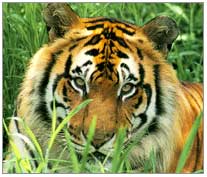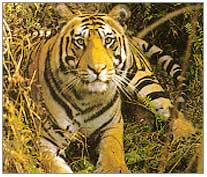RAJASTHAN TOURISM Tour Highlights National Park
National Park
Ranthambore National Park
Ranthambhor National Park, before a princely game conserve is the scene where the celebrated Indian Tiger is best seen. Ranthambhor Tiger Reserve lies on the junction of Aravali and Vindhyas just 14 Kms from Sawai Madhopur in Eastern Rajasthan. It sprawls over a varying and undulating landscape. The scenery changes dramatically from gentle and steep slopes of the Vindhyas and sharp and conical hills of the Aravali. A tenth century fort also blends amicably with the background.

Pure sands of Dhok (Anogeissus pendula) interspersed with grasslands at the plateaus, meadows in valleys and luxuriant foliage around the canals make the jungle. Three big lakes - Padam Talab (meaning Lake), Malik Talab and Raj Bagh - are similar turquoises studded in the vast forest that abounds with aquatic vegetation including duckweeds, lilies and lotus.
A significant geological feature within the park is the 'Great Boundary Fault' where the Vindhaya plateau meets the Aravali range. The Rivers Chambal in the South and the Banas in the North bound the National Park. The park is dotted with steep rocky hills and the dominating architecture of Ranthambhor Fort (built in the 10th century), adds to its landscape. The rugged park terrain alternates between dry deciduous forest, open grassy meadow, dotted by several lakes and rivers that are only made passable by rough roads built and maintained by the Forest Service.
The tiger is not the only attraction at Ranthambhor; although it is the one park resident that people come to see. A variety of birds including Owlets, the ubiquitous Langur (monkey), Leopard, Caracal, Hyena, Jackal, Jungle Cat, marsh Crocodiles, Wild Boar, Bears and various species of Deer are the other attractions.
Bandhavgarh National Park
Set amongst the Vindhyas, in Madhya Pradesh, Bandhavgarh is a small national park, but with the highest known density of tiger population in India. This is also known as White Tiger territory. These have been found in the old state of Rewa for many years. The other species found in abundance in Bandhavgarh are the gaur or Indian bison, the sambar, the barking deer and the nilgai.
The Park is spread over an area of 437 sq. km.The terrain is made of rocky hills, sal forests and grazing areas, formerly agricultural land. The finest of these hills is the Bandhavgarh hill, and on its highest point stands Bandhavgarh Fort. Though no records remain to show when the fort was constructed, it is believed to be about 2000 years old. Several dynasties have ruled the fort: for example, the Maghas from the 1st century A.D, the Vakatakas from the 3rd century; the Sengars from the 5th century, and the Kalachuris from the 10th century.The oldest signs of habitation, are the caves dug into the sandstone, near the fort. Several of these contain Brahmi inscriptions dating from the 1st century B.C. Prior to becoming a National Park, the forest range around the region had been maintained as a Shikargarh, or game preserve, of the Maharajahs of Rewa. It was only in 1968, that the area was declared as a National Park. Since then, stringent steps have been taken to retain it as an unspoilt natural habitat.
Kanha National Park
The Kanha National Park, stretching over 940 sq km, the vegetation, chiefly
made of sal and bamboo forests, grasslands and streams, this park is the
sole habitat of the rare hardground barasingha.
The forests of the Banjar valley and Halon valley, respectively forming Kanha's western and eastern halves, had even , at the turn of the century, been famous for their deer and tiger population. By a special statute in 1955, Kanha National Park came into being. Since then, a string of stringent conservation programmes have been launched, for the overall protection of the park's fauna and flora. It is one of the most well-maintained National Parks in Asia, and a major attraction for avid wildlife buffs all over the world.
Kanha boasts of about 22 species of mammals. Some of the inhabitants of this park are the gaur, the largest of the world's cattle; the sambar, the largest Indian deer; and the chausingha, the only four-horned antelope in the world. Other frequent visitors include the Nilgai antelope, the sloth bear, the dhole, or Indian wild dog, and an occasional panther. Some 200 species of birds inhabit the park, that include the cattle egret, black ibis, hawk eagle, and the red-wattled lapwing. Shravantal is an old, earthenbound tank in the central Kanha meadows, which happens to be an important watering hole, for a large number of water fowl in winter. Bamni Dadar, known as Sunset Point, is the most beautiful section of the park, and the view of the sunset from this spot is absolutely mesmerising. Quite a few animals can be sighted around this area which include the sambar, gaur, the four-horned antelope and the barking deer.
Corbett Wildlife Park
Nestling in the foothills of the Himalayas, the Corbett National Park
extends over an area of 520.82sq.km. Varied topography and vegetation
gives Corbett a rich diversity in habitats and natural beauty. Flat valleys
are interspersed with hilly ridges and the Park's rolling grasslands known
as the Chaurs provide visitors with an excellent view of its inhabitants.
The magnificent Ramganga River flows through the entire length of the
Park and little forest streams tumble through the ravines.

While dense stands of sal cloak the higher ridges, mixed deciduous forests are found throughout the Park and over 110 varieties of trees, 51 species of shrubs and over 33 kinds of bamboos and grasses are seen here.
Corbett has the highest density of tiger in the Country - approximately one every 5 sq.km. and it was here that the prestigious "Project Tiger" was launched in 1973. Four of deer - hog deer, samber, chital and barking deer and other prey like the wild boar, support the predator.
Besides the tiger, Corbett is a haven for 50 mammals, 580 kinds of birds and 25 reptile species. The Park has elephants, the Himalayan black , bear in the higher elevations, sloth bear, varieties of lesser cats, dhole -the wild dog and an entire spectrum of colourful birds including water birds, pheasants, jungle fowl and the Indian hornbill.
Basking along the banks of the Ramganga are the slender snouted gharial and the mugger or marsh crocodile. The river is rich in the magnificent mahaseer - a fine sporting fish prized by anglers, though angling is not permitted inside the National Park. Excellent facilities for staying and viewing wildlife make Corbett one of the finest reserves in India.
Ranthambore National Park - Best Price with Free Itinerary Suggestion









